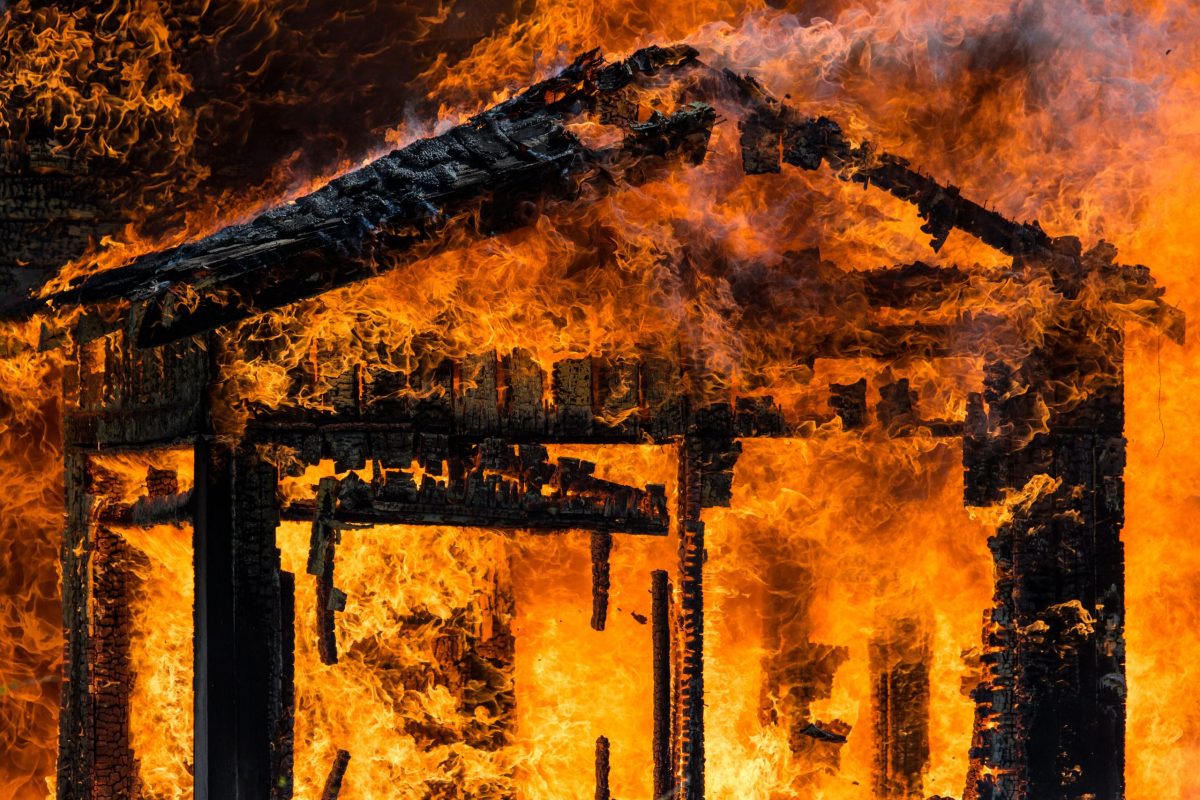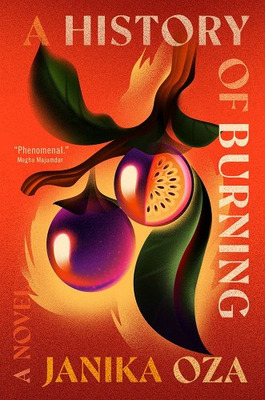interviews
A Secret Reverberates Across Four Generations of an East African Indian Family
Janika Oza fictionalizes her family's immigration story in "A History of Burning" to question complicity, safety, and belonging

In her debut novel A History of Burning, Janika Oza gives us the story of a family, one migration journey at a time. Beginning with indentured labor that leads the first member of the family, Pirbhai, from his home in India to East Africa, we follow four generations across several continents and over one hundred years. In the next generation, Pirbhai’s daughter Rajni faces a second exile when she and her family are forced to leave Uganda during the expulsion of Asians in 1972. The family is set to migrate to Canada, but at the last minute, her revolutionary daughter Latika chooses a different path. Starting school in a new country, Latika’s son Hari feels the weight of these social and personal fissures before he even discovers the whole truth about his kin. The narrative ends in 1990s Canada in the midst of the Rodney King protests, though the family’s arc is far from finished. As Oza puts it, the ending is not an answer, but rather, a landing point.
Oza is a master of time, equipped with the ability to render a historical arc in mere paragraphs or to expand a single moment into the joys and sorrows of a lifetime. In 2022 Oza won the O. Henry Prize for her gripping short piece Fish Stories, originally published in The Kenyon Review. It’s a piece I can’t stop passing around between my students and colleagues, who become equally gripped by its sensory detail, its interplay between reality and grief, and its immense heart.
I had the privilege of reading early excerpts of A History of Burning during a Tin House workshop in 2019, led by Ingrid Rojas Contreras. Even then, the viscerally moving nature of the story leapt from the pages. That same year, a chapter of the novel was longlisted for the 2019 CBC Short Story Prize and published in Prairie Schooner.
Recently, Oza and I sat down to have a conversation about the novel. We spoke about who gets to feel safety and security, writing an intergenerational narrative, and finding inspiration in her family history.
Rosa Boshier González: A History of Burning stays true to its title by cataloging the symbol of fire throughout the novel. Can you unpack this symbol and how it shifts through the book? And why was that symbol of burning important to you?
Janika Oza: I wanted a title that spoke to the themes of complicity and resistance running through the book. I landed on burning because when we think of a burning, what usually comes to mind is something that’s destructive or harmful or violent. Very often that’s true. But a burning can also be something that is purposeful or regenerative, like a controlled burning of a forest to encourage new growth. Throughout my novel, both of those possibilities are there.
RBG: I’m curious about the way that implication works in A History of Burning. Throughout the novel, you very deftly render the prejudices on both sides of ethnic and social conflicts, be it between Asians and Africans in Uganda and Kenya or white Canadians and recent immigrants in the wake of the Rodney King protests in 1991. Without giving too much away, towards the end of the novel there are twin acts of violence between two parties with very different ideologies. Was this a motif you were actively working towards?
JO: Bookending the motif of burning was not something I was actively working towards. But when I was thinking through these questions of complicity and resistance, I came up against questions of security and belonging: Who gets to feel safety and security in these countries? What does it mean for us to find refuge in a place that is also causing harm to other communities? What does safety mean in that context?
What does it mean for us to find refuge in a place that is also causing harm to other communities?
The Rodney King protests in Toronto spiraled into a solidarity movement and series of internally-motivated protests around racial violence and police brutality; that felt like another moment to really dig into those questions of safety, and to consider how different communities are experiencing these adopted homes, which we’re told are havens. In many ways they are and in many ways they are not.
RBG: Can you talk to me about the chronology of the book?
JO: The reason why I wrote it chronologically is partly because of the scope. The novel spans over 100 years. So for pure practicality, I ended up doing it that way.
Something else that was really important to me in the novel was being able to see the movements of, not only this family, these people, but of the movements through the generations of ideas, emotions, of trauma, of memory, all of that making their way through the earliest generation into the final generation in Toronto. The challenges that the first generation was grappling with—when they experienced rupture, when they faced being a part of this colonial construct and attempting to secure a place for themselves while also living true to themselves, while also taking care of their families—those continue through the other generations.
The youngest generation around the time of the protests in the ‘90s in Toronto are also still struggling with those same things and still struggling with how to live on this land and in community, and how to take care of one another and live with intention, and also survive. I could see this thread sort of moving through the generations, through the different times, through the different movements, whether it was independence in Uganda in the ‘60s or what we were just talking about in Toronto in the ‘90s.
RBG: Has writing about social protest movements over the last hundred years informed your thinking around social movements today or your responses to them? Are contemporary social movements something that you’re interested in writing about in the future?
JO: They’re certainly something I’m interested in writing more about. It’s so different today with the internet and social media. Social movements are organized and constructed through these new platforms. Of course, it allows for accessibility and reach, and also brings up new challenges of, like, actually engaging. We see so much performativity in politics. So I think writing about current events, whether in fiction or nonfiction, would be an entirely different kind of challenge, but it was definitely something I was holding in my mind as I wrote A History of Burning.
RBG: This story spans a large amount of time—1898 to 1991—and four different generations. It has a prismic quality to it; we learn something new with each character. Why was an intergenerational narrative crucial to the telling of this story?
Janika Oza For me, the root of that is in my own family history and coming to this novel knowing very little about my family history. Three generations of my family lived in East Africa and then were expelled under Idi Amin’s dictatorship. It was not talked about very much. As I grew older, I became very interested in the fact that we didn’t talk about it. I realized somewhere along the way that I couldn’t write this novel if I wasn’t speaking to my family and my community about it.
When we think of a burning, it’s something destructive. But a burning can also be purposeful or regenerative, like a controlled burning of a forest to encourage new growth.
A lot of the research process for this novel was through conversation and interview. I would speak to people who were in my generation, like me, descendants of this history. Mostly I was speaking to people who are in their 50s, 60s, 70s or even older who had real memories of this time and. It felt really important for me to honor that intergenerational exchange that I was able to engage in in writing this book and to put some of that into the novel itself. There was a lot of love in that research process.
It also felt very important for me to explore the ways that, despite the breadth of time and place, that these characters our continually grappling with these same questions, and also to show the ways that, from one generation to the next, certain experiences, manifest in each generation, even if they’re not spoken about, even if a character has no idea what one or two generations before them went through. It is still somehow a part of their own lived experience.
RBG: This research seems to be a reclamation of the Western understanding of archive.
JO: In my research I soon realized that there was very little written about this branch of history. This was yet another example of the erasure and the rewriting of a community’s history. That is when I realized that I would have to do the hard, scary thing and talk to my family and talk to my community. So I asked for help.
My family connected me with more family who connected me with friends who connected me with temples. It was this chain that spread all across the world and all the places that our people scattered. There were a lot of WhatsApp conversations and Zoom and Skype calls. Going into the research, I would have a few larger points I would want to come towards but I would mostly allow the conversations to go where they did, knowing that it’s a very sensitive history, one that has not been spoken about very much. Sometimes it would take several conversations.
What was so special and beautiful about that process was that it really was this collective remembering and sharing. I still have some descendants of the Expulsion of Asians in Uganda, people of my generation, who will text me and say, my family just sat down and had this conversation and told these stories that we’ve never heard before. So there was this sense of an opening. I think there is a lot of freedom and power in being asked to share your story and to tell it the way that you remember it.
RBG: In the first third of the novel, when Rajni tends to her child while also grieving, she decides that she is “whole enough to go on.” That struck me as a throughline in the book—characters who persevere, survive, and root out joy within their kinship again and again. Can you speak to this orbital resilience?
JO: I think the question of resilience is something that is tricky because ideally we shouldn’t have to be resilient. While resilience can be made to sound like something that is active, it’s actually reactive. It’s in response to repeated pain or suffering.
But it’s also undeniable that the characters in this book have experienced over time fractures and upheavals and are doing the only thing that they know how to do in those situations, which is persist.
For many of the characters, there’s an imperative to go on for the people we love. There are times in the book where this comes at a cost. To the characters themselves, to those in positions of caretaking, like the moment you were just mentioning with Rajni. I think there are times when characters are called on to be selfless or self-sacrificing.
RBG: How did your graduate work and professional background inform your writing?
JO: Yes, definitely. I worked as a refugee settlement counselor and then a school settlement counselor, working with immigrant refugee families and navigating the settlement process, from housing to jobs to everything in between. Much of the time that I was writing this book, I was working in those environments. I was thinking a lot about my own position as someone who was born and raised in Canada, but whose family has come from elsewhere. I was really thinking about what can change over the course of one to three generations. I was thinking a lot about support. I was in a role that was attempting to offer some kind of support to people who are in those very precarious situations. I was thinking about, in the ’70s, when my family and community were going through this, what kinds of supports were and weren’t there, and also all the ways that this is not an equal terrain. Everyone does not receive the same supports or possibilities. The work opened my eyes to the bureaucracy and the actual gritty truth of migrating. I had me thinking a lot about the structures that make community possible, the necessity of that as the most. Integral support when a person has had to leave the place that they know, they often are leaving family and all their networks behind.
RBG: In that same SmokeLong Quarterly interview, you asked, “Who am I fighting for on the page? What language do I need to do that justice?” What were your answers to those questions for A History of Burning?
JO: When I think about language, I think about literally what languages and I using to tell this story. And of course, it’s a book that I wrote in English. But it felt very important for me to also have lines and phrases be Swahili and Gujarati and to not give away a distinction between these languages, because the way that I learned them was very mixed. It comes out in daily life. To this day, there are words that we say at home that I don’t know if they are Swahili or Gujarati. It’s a testament to the places that my family comes from and the ways that our communities integrated and moved. So it felt necessary for me to honor that hybrid language throughout the book.
The other place my mind goes when we talk about language to do this story justice is related to time. It took a long time for me to write this book. I was learning to write a book as I was writing this book, but I was also learning to listen to the stories of my family and my people. I was learning to sit with these histories that were often difficult to hear. I was learning to sit with the discomfort of learning things about my family or the places we’ve come from that I had never known. And all the complexity of being a migrant community in another colonized place. I think I had to give myself a lot of time to distill all of that and to really think about what I wanted to share, w pieces of family history, community history felt necessary to put into this book, what stories I wanted to keep close to my chest, and allowing for there to be purposeful silence. Allowing for it to be an actual choice, what I was writing and what I was not.









